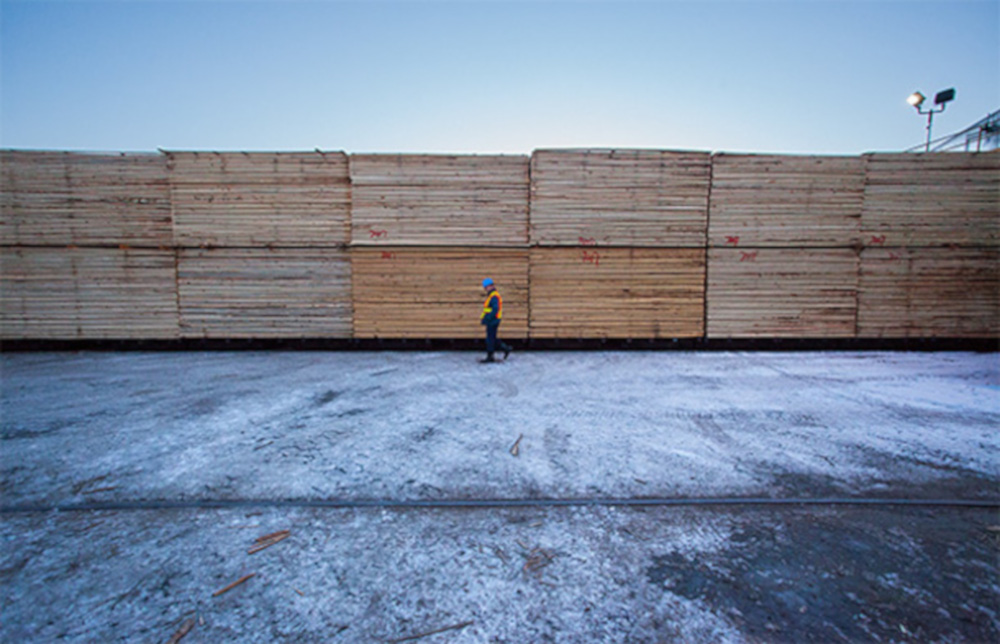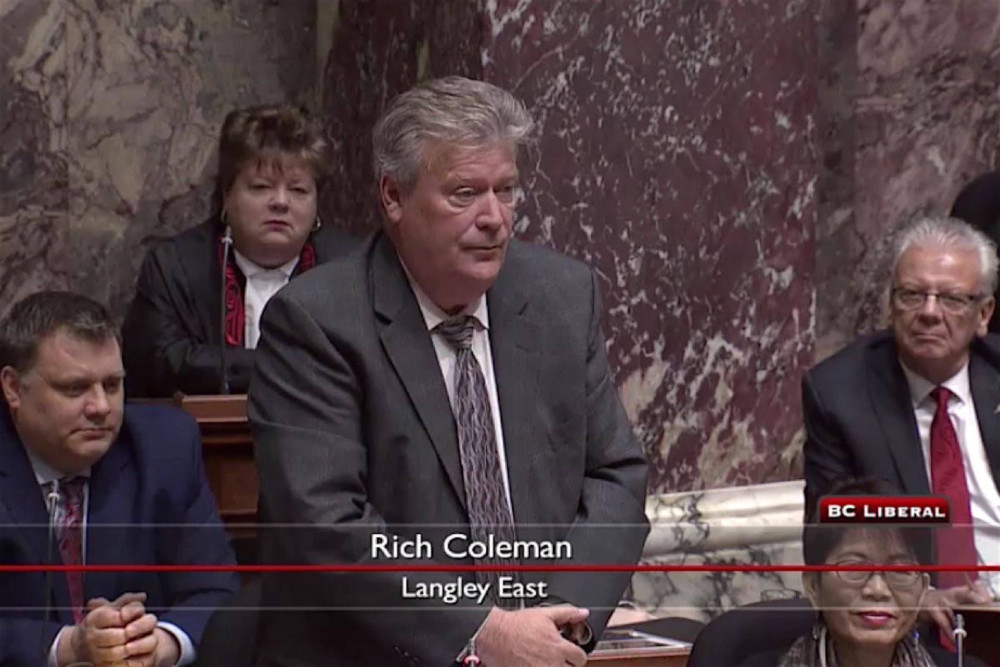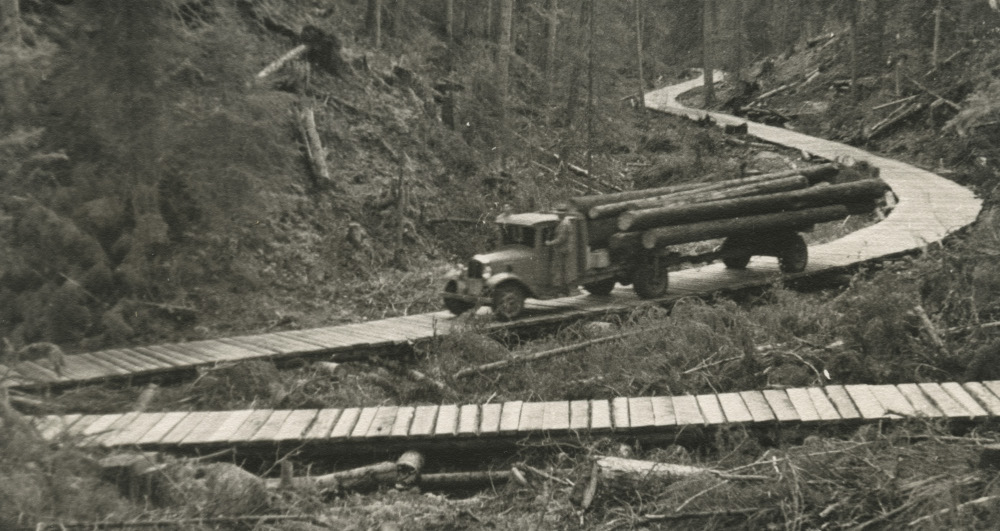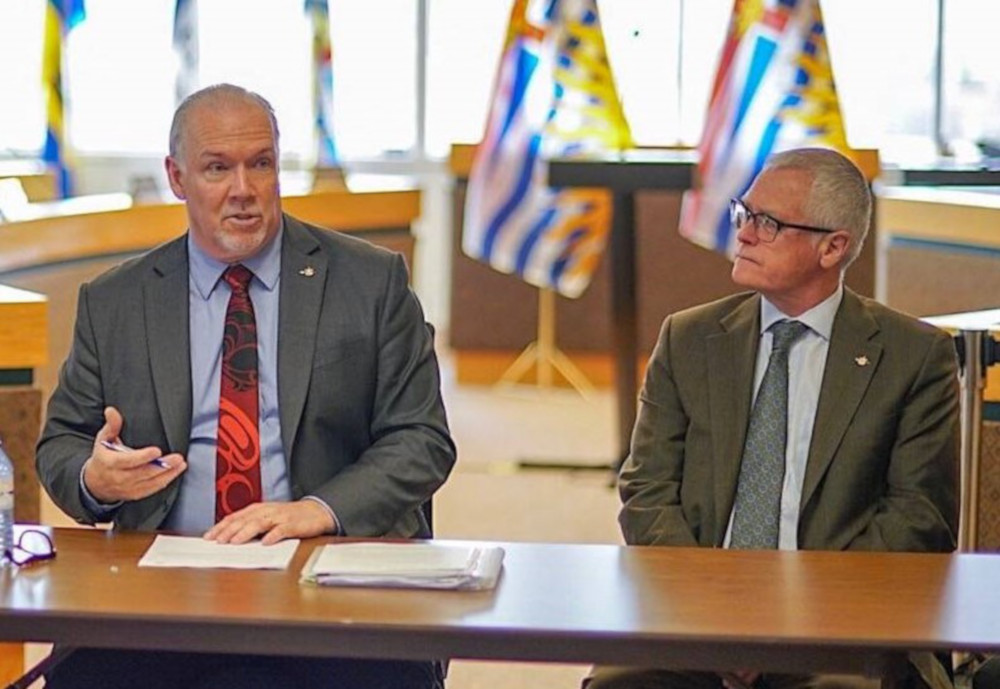Rich Coleman was not having a good day, not at all.
It was March 3, 2008, and Coleman — the BC Liberal minister of forests and range — was in the legislature being pummeled by a succession of New Democratic Party MLAs.
Carole James, then the NDP leader, led off a raucous Question Period by noting the mounting number of forest-industry job losses under the BC Liberal government.
She then directed a question to premier Gordon Campbell, asking if “his only plan is to stand by and watch as more mills go down and more jobs are lost?”
Campbell stayed glued to his chair and let Coleman take the heat. “The member knows, and we all know, that right now B.C.’s forest industry is facing one of the most difficult times probably in the history of our province.”
Fifteen minutes later, after being repeatedly battered by the New Democrats, Coleman complained: “the members [opposite] are getting up and saying: ‘It’s your fault, your fault, your fault.’”
Then, a startling admission: “... And I don’t like it. It’s not fun being the minister of forests and having to deal with situations that affect people.”
Two months later, on May 13, James again rose at the start of Question Period and challenged the government’s handling of B.C.’s forest sector.
“Yesterday I was in Kamloops with hundreds of forest workers as the city’s sawmill closed down. It’s a story we’ve seen over and over again under the BC Liberals’ failed forest policy,” she began.
“I’ve listened to workers and their families. I’ve listened to the communities. They’re looking for leadership.”
James then asked for Coleman’s resignation. “B.C.’s forest industry is collapsing. This government is ripping the heart out of communities.” Would the minister of forests “own up to his failure, his failed hands-off approach, and step down today?”
Coleman refused to do so, but his tenure as forests minister was drawing to a merciful close. Three weeks after the spring sitting had concluded, Campbell shuffled his cabinet. Coleman settled in at the much-quieter portfolio of housing and social development where, presumably, he could have a little more “fun” than he had at forests.

British Columbia’s Legislative Assembly resumes sitting today after a four-month summer hiatus, and it’s near certain that the opposition BC Liberals will make recent sawmill closures and forest-related job losses a major topic of debate over the 20-day fall session.
Numbers are not precisely known because some forestry workers have been laid off only temporarily, and several sawmill operations closed just until economic conditions improve.
That said, roughly two dozen mills this year have announced either temporary or permanent shutdowns, with four to six thousand jobs lost for a few weeks, several months, or even permanently.
B.C.’s forest sector has been plagued with uncertainty and downsizing for much of the last four decades. But that doesn’t appear to matter to the BC Liberals, now sitting on the opposition benches after holding the reins of power from 2001 to 2017. Only recently have they seemed to have become aware of the many travails endured by B.C.’s forest sector.
“The NDP are basically missing in action on the forestry file,” BC Liberal MLA John Rustad declared in a July 15 news release.
“There is crisis in the forest industry that is having ripple effects throughout the entire provincial economy,” the former cabinet minister and currently his party’s forests critic said, “and we have a government that is basically sitting on its hands and doing nothing.”
Rustad’s comments followed a letter he and BC Liberal leader Andrew Wilkinson wrote on June 13 to NDP Premier John Horgan, which outlined five rather feeble proposals to assist a “struggling” forest industry.
The BC Liberals’ recommendations — subsequently reconfigured in the mid-July news release — called on Horgan to ask Ottawa for federal assistance, and set up new bureaucratic entities such as a Cabinet Working Group and “a forestry competitiveness committee” which would include opposition MLAs.
Incredibly — in what may be the most blatant example of political amnesia ever seen in our province — the BC Liberals also challenged Horgan to boost spending on social services for “workers and their communities.” Monies also should be sent to displaced forestry workers to pay for their participation in forest-fuel mitigation projects.
Is it possible the BC Liberals have entirely forgotten their 16-year tenure in government?
Under the leadership of Gordon Campbell and Christy Clark, Rustad, Wilkinson and their colleagues enthusiastically and repeatedly slashed funding for social services, notably child welfare, and reduced public spending to the bone so as to finance private-sector tax cuts.
The Campbell Liberals even shuttered hundreds of public schools, forest-service offices and courthouses in the province’s interior and north regions, hurting in the process countless rural town residents.
And to rub salt in their wounds, the BC Liberals’ most noteworthy response was to launch a silly public-relations campaign that attempted to re-brand parts of the province as “The Heartlands.”
But that was then, this is now — and the BC Liberals today seem to think that Horgan and the New Democrats should spend oodles of monies on something, anything, in response to on-going changes in the province’s forest sector.
Calculating forest-related jobs lost under BC Liberals
Missing from the June 13 letter to Horgan and the re-written July 15 news release — and nowhere to be found in more than 30 forests-related news releases issued by the BC Liberal caucus since May — was any mention of the industry job losses incurred when their party ran British Columbia.
Thanks to the precision with which Statistics Canada counts all things economic, however, we can get very specific numbers. (The numbers below are from Natural Resources Canada’s representation of Statistics Canada data, specifically the Survey of Employment, Payrolls and Hours, or SEPH.)
In 2000, the year before the Campbell Liberals rose to power in B.C., the number of workers in the province’s forest sector was 97,131.
Seventeen years later, when Clark’s administration fell on a confidence vote in the Legislative Assembly, the comparable number was only 52,435.
That works out to the permanent disappearance of 44,696 forest industry jobs under the BC Liberals.
Viewed another way, our province annually lost an average of 2,600 forestry-related jobs — 220 positions every week — during the BC Liberal Party’s tenure in government.
Where were the greatest job losses?
Again, looking to Statistics Canada, it is evident that sawmill employment during the BC Liberal era collapsed from 43,352 to 27,117, which represents the permanent loss of 16,235 jobs. (The category officially is known as “Wood product manufacturing industry.”)
The number of jobs in “Support activities in the forest industry” — which includes timber cruising, forest-fire fighting, reforestation and log-hauling (truck driving) — plunged by 11,303 (from 16,653 to 5,350). That’s a loss of about 68 per cent, or two-in-every-three positions.
Near-comparable losses were incurred in the “Pulp and paper product manufacturing industry,” as a total of 10,919 jobs were permanently destroyed. (Employment plummeted from 18,831 in 2000, to 7,912 in 2017, a loss of 58 per cent.)
The fourth category, “Forestry and logging industry,” fared the best, relatively speaking. Under the Campbell and Clark regimes, employment fell from 18,295 to 12,056. That’s an irreversible loss of 6,239 jobs — or about one-in-every-three positions.

A review of Hansard and debates in B.C.’s Legislative Assembly when the BC Liberals ruled the province reveals little concern for mounting forest-sector job losses on the part of government MLAs and cabinet ministers.
A good example is found on Nov. 26, 2007, when the NDP opposition introduced Motion 84, and called for “the government [to] immediately convene an emergency summit on the future of forestry in this province.”
At that point, according to Statistics Canada, the province had lost approximately 30,000 forest-related jobs, but the BC Liberals spoke against the motion — with the ubiquitous John Rustad leading the charge.
“I think the drama that seems to be worked into this might be a little bit overstated,” he began.
“We are definitely going through a tough patch at the moment in the forest industry,” Rustad continued, “perhaps one of the toughest patches that we have seen in 30 or 40 years.”
Later, Rustad explained why he could not support the motion. “We don’t need doom and gloom.”
The real roots of BC forestry’s hard times
Let’s put politics aside for a moment and look at why not just Rich Coleman but a long succession of forests ministers over the last four decades haven’t had much fun overseeing the industry.
There will be quite a few numbers to ponder, but two are most important: 1979 and 1.5 million.
The first integer, 1979, marked the year after which, in the words of economist Robert C. Allen, “the geographical expansion” of B.C.’s forest industry was “no longer possible.”
In the province’s earliest days nearly all logging and milling activity took place near tidewater, significantly on Barkley Sound on Vancouver Island and Burrard Inlet in the Lower Mainland.
There was some logging and sawmill activity in the Interior, notably during the Cariboo Gold Rush in the 1860s as miners built houses, flumes and waterwheels, but it was a minor side-line to mining and other activity.
The arrival in B.C. of the Canadian Pacific Railway in 1886 opened up sections of the Central Interior for settlement and development. Soon the railway also provided the means to transport vast quantities of lumber and other wood products eastward to the prairies where the population was exploding.
Thanks to the CPR and immigrant settlement, the number of people living on the prairies grew from less than 120,000 in 1871, to more than 1.3 million in 1911, and two new provinces — Saskatchewan and Alberta — were created.

B.C.’s forest sector continued to grow following the construction of several new rail-lines in the second decade of the 20th century. Not only could loggers and sawmill workers set up operations in areas previously accessible only by trail and packhorses, they now could ship out — on rail cars — lumber and other forest products to customers in distant corners of the world.
The completion in 1914 of the Panama Canal led to a drastic reduction in the price of B.C. lumber on the east coast of the United States, drawing massive exports.
It was in the late 1940s, after the conclusion of the Second World War, that the real boom got underway. Bulldozers punched hundreds of miles of new roads, quickly dubbed “logging roads,” all across the province’s vast and remote regions. They were followed by the establishment of new (albeit often very small) sawmills that employed many thousands of workers.
Pre-war, B.C.’s forest industry was dominated by operations on the coast, but in the post-war period Interior mills produced about two-thirds of the province’s total lumber output.
According to Allen — a University of Oxford economics professor who taught at UBC from 1980 to 2000 — the volume of timber harvested annually in B.C. grew from 6.7 million cubic metres in 1912, to 76.2 million in 1979.
That increase was accomplished, Allen wrote in a prescient essay — “B.C.’s Economy: Past, Present, Future,” published more than 30 years ago — “by extending the geographical area exploited.”
By 1979, however, that expansion had reached the edge of the province’s geographic boundaries. With nearly all of the province divided into Timber Supply Areas, the forest industry had reached the limits of sustained yield management.
“Although no one knew it at the time, 1979 was as significant a year as 1886,” wrote Allen. “1979 was the year the timber frontier closed.”
No longer could the forest industry make sizeable profits merely by expanding the scope of their operations. They had to become more efficient, which meant a greater reliance on fixed capital and new technology, and a drastic reduction in labour costs.
The second of our two numbers, 1.5 million, refers to the average number of housing starts each year in the United States, the biggest market for B.C. forest products, since the end of the Second World War.
From 1946 through to the present day, the U.S. population grew from about 140 million to 330 million. That’s an annual average increase of approximately 2.6 million people.
All of those new Americans needed homes in which to live, and B.C. was a major source of lumber and other wood products.
But over the last decade or so, housing starts in the U.S. — even as the population continues to rise each year by about 2.6 million people — have not regained their former heights.
According to the U.S. Census Bureau, housing starts between 1959 and 2007 rose by an annual average of 1.547 million.
The number never fell below one million. Until 2008, that is, when housing starts dropped below 906,000. That number plunged even further in 2009, to a miserable 554,000.
Between 2008 and 2018, U.S. housing starts have averaged 918,000 — less than two-thirds the previous annual average since the Second World War.
To be sure, housing starts south of the border have increased in recent years, but they look to top out at less than 1.3 million annually and may never again reach their post-war average.
Why? In part it’s because an increasing proportion of young people — that is, those between the ages of 25 to 34 — are opting not to lead their own household.
Research by the National Association of Home Builders has found that “increasing numbers of young adults now choose to live with their parents or parents-in-law,” as well as sharing housing with roommates, housemates and other non-relatives.
As a consequence of the decline in American housing starts since 2008, B.C. lumber exports to the U.S. have also been falling.
The peak year for softwood lumber exports from B.C. to the U.S. was 2005, as the province sent an astounding 28.7 million cubic metres of lumber to American customers.
Four years later, in 2009, that number plummeted to just 11.9 million cubic metres.
Even after a slight recovery, B.C. softwood lumber exports south of the border last year, in 2018, were only 15.5 million cubic metres — or about half the volume in 2005.
A hot seat with splinters
It is clear that the challenges facing B.C.’s forest industry far exceed the ability of one individual to correct or even successfully mitigate.
But such is the task for whomever is wearing the title of forests minister.
Later today, when the Legislative Assembly resumes sitting, the man on the hot seat will be Doug Donaldson, the NDP MLA for Stikine — and since July 2017, the province’s minister of forests, lands, natural resource operations and rural development.
Donaldson may expect to come under a withering fire in the legislature from the opposition BC Liberals in the coming weeks, and he ought to be forgiven if every once in a while he looks across the aisle at Rich Coleman and recalls that for a very long time the forests minister’s job hasn’t been very much fun. Not at all.
Disclosure note: The writer, Will McMartin, a widely published political analyst and long-time contributor to The Tyee, does political consulting and lobbying in B.C. His clients are not related to the forest industry, nor do they include the current government. ![]()
Read more: Local Economy, Labour + Industry, BC Politics















Tyee Commenting Guidelines
Comments that violate guidelines risk being deleted, and violations may result in a temporary or permanent user ban. Maintain the spirit of good conversation to stay in the discussion.
*Please note The Tyee is not a forum for spreading misinformation about COVID-19, denying its existence or minimizing its risk to public health.
Do:
Do not: